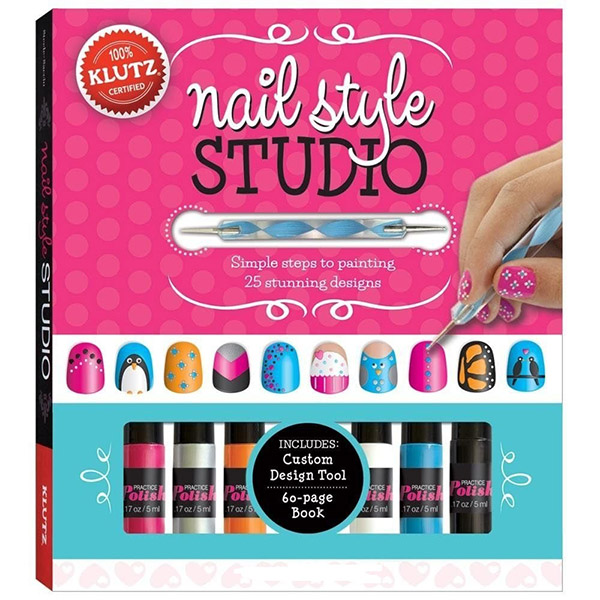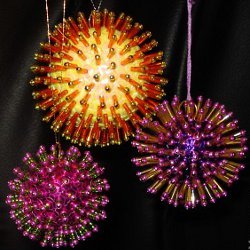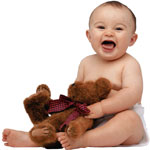Choose a toy for your child
 A huge number of modern toy toys can be conditionally divided into two groups:
A huge number of modern toy toys can be conditionally divided into two groups:1. Toys that promote social and emotional development (or development of the personal sphere). This group includes numerous toys, suggesting communication or treatment with them as with living characters. These are toy animals (bears, bunnies, dogs, etc.) and of course puppets with all kinds of doll utensils.
In addition to dolls with their clothes, furniture and utensils, they need sets for playing doctor, hairdresser, shop, etc.
These are the details of the costume and the attributes that help to takeand hold the playing role (robe and bandage doctor, the steering wheel for the car, a police cap, a red cap, etc.). In the same group can be attributed to trans-port toys (trucks, trains, cars, allowing something to be transported).
2. Toys that promote the development of intellectual-cognitive and motor abilities of children.
These are all kinds of cubes, constructors, puzzles, mosaics, lotto, dominoes, etc.
This separation is extremely convenient, becauseallows you to determine for each age the main line of development and the activities corresponding to it, and therefore to allocate priority types of toys for children of every age. So, for example, for children from 1 to 3 years the main, leading activity is the subject, in which the child takes various actions with objects, learns to correlate the shape, size, location of individual parts.
Therefore, children of this age need first of alltoys of the second group. And in the preschool age (from 3 to 6 years) the leading activity is a role-playing game, for which toys of the first group are needed.
In addition to the identified two lines of development, there isthe third. This is the physical development and upbringing of the child. The task of strengthening health, and the formation of the physical qualities of the child (strength, endurance, agility, accuracy, etc.) is the most important for the upbringing of children. Naturally, this line of child development is embodied in a variety of special game aids and involves special methods of action (balls, hoops, skipping ropes, skittles, etc.). Therefore, toys that promote the development of physical qualities and motor skills should be singled out separately.
So, proceeding from what has been said, it follows that the first andthe necessary requirement for a toy is its potential opportunity to become the subject of the child's appropriate action (activity). Choosing fun for his son or daughter, it is necessary, on the one hand, to focus on his age (and therefore the main type of activity), and on the other - to strive to ensure that they have at their disposal all kinds of toys that contribute to the development of various spheres of life of the child. The possibility (or impossibility) of the child's active action depends on many qualities, for example - the size of the toy. Huge soft animals (dogs, hippopotamuses, elephants), which the kid can not even pick up, can serve as a room decoration or pillow, but not a child's play. The same soft toys of smaller sizes can be used in the children's game.
Of great importance are the technical qualities. If the rings of the pyramid are worn with difficulty on the rod, the parts of the doll are linked together with a creak, and the wheels of the machine are poorly scrolled, the child can not perform the appropriate actions with these toys, although these types of toys themselves have undoubted developmental value. Sometimes it seems to adults that the more different qualities and qualities a toy contains, the better. So, it would seem that a plastic elephant on wheels, which is both a locomotive and a telephone, opens a variety of possibilities for children's activity.
But such a "diversity" disorients the child -he does not know what to do with such a complex toy - carry, talk on the phone or feed the elephant. Moreover, the full implementation of all these actions is very limited - it is impossible to transport anything on such an elephant (you will not put anything and you will not plant anyone), the handset keeps falling, and the elephant is not fully elephant, as it is a phone on wheels. It would be much more useful in this respect to "disconnect" these functions and offer the child three different and understandable by their purpose and in the manner of the action items.
</ p>
These are the details of the costume and the attributes that help to takeand hold the playing role (robe and bandage doctor, the steering wheel for the car, a police cap, a red cap, etc.). In the same group can be attributed to trans-port toys (trucks, trains, cars, allowing something to be transported).
2. Toys that promote the development of intellectual-cognitive and motor abilities of children.
These are all kinds of cubes, constructors, puzzles, mosaics, lotto, dominoes, etc.
This separation is extremely convenient, becauseallows you to determine for each age the main line of development and the activities corresponding to it, and therefore to allocate priority types of toys for children of every age. So, for example, for children from 1 to 3 years the main, leading activity is the subject, in which the child takes various actions with objects, learns to correlate the shape, size, location of individual parts.
Therefore, children of this age need first of alltoys of the second group. And in the preschool age (from 3 to 6 years) the leading activity is a role-playing game, for which toys of the first group are needed.
In addition to the identified two lines of development, there isthe third. This is the physical development and upbringing of the child. The task of strengthening health, and the formation of the physical qualities of the child (strength, endurance, agility, accuracy, etc.) is the most important for the upbringing of children. Naturally, this line of child development is embodied in a variety of special game aids and involves special methods of action (balls, hoops, skipping ropes, skittles, etc.). Therefore, toys that promote the development of physical qualities and motor skills should be singled out separately.
So, proceeding from what has been said, it follows that the first andthe necessary requirement for a toy is its potential opportunity to become the subject of the child's appropriate action (activity). Choosing fun for his son or daughter, it is necessary, on the one hand, to focus on his age (and therefore the main type of activity), and on the other - to strive to ensure that they have at their disposal all kinds of toys that contribute to the development of various spheres of life of the child. The possibility (or impossibility) of the child's active action depends on many qualities, for example - the size of the toy. Huge soft animals (dogs, hippopotamuses, elephants), which the kid can not even pick up, can serve as a room decoration or pillow, but not a child's play. The same soft toys of smaller sizes can be used in the children's game.
Of great importance are the technical qualities. If the rings of the pyramid are worn with difficulty on the rod, the parts of the doll are linked together with a creak, and the wheels of the machine are poorly scrolled, the child can not perform the appropriate actions with these toys, although these types of toys themselves have undoubted developmental value. Sometimes it seems to adults that the more different qualities and qualities a toy contains, the better. So, it would seem that a plastic elephant on wheels, which is both a locomotive and a telephone, opens a variety of possibilities for children's activity.
But such a "diversity" disorients the child -he does not know what to do with such a complex toy - carry, talk on the phone or feed the elephant. Moreover, the full implementation of all these actions is very limited - it is impossible to transport anything on such an elephant (you will not put anything and you will not plant anyone), the handset keeps falling, and the elephant is not fully elephant, as it is a phone on wheels. It would be much more useful in this respect to "disconnect" these functions and offer the child three different and understandable by their purpose and in the manner of the action items.
Read more:

Gifts for the New Year to children, ideas with photos. Variants of gifts for children for the New Year 2017 in kindergarten and school

How to choose Christmas trees?

Gifts for the New Year to children, ideas with photos. Variants of gifts for children for the New Year 2017 in kindergarten and school

Christmas tree toys with own hands

Bouquet of soft toys with your hands: master class, photo, video for beginners

We sew soft toys Tilda own hands, patterns and photos of soft toys Tilda, how to make a doll from a fabric to beginners, soft toys for an interior

Christmas tree toys with own hands

Bouquet of soft toys with your hands: master class, photo, video for beginners

We sew soft toys Tilda own hands, patterns and photos of soft toys Tilda, how to make a doll from a fabric to beginners, soft toys for an interior

Why do we need toys for dogs?

Development of the child from the first days of life

Bath toys

Children's educational toys

What toys do children need?